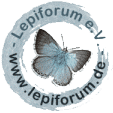

 +12Kontinente:EUAS
+12Kontinente:EUAS1. Lebendfotos
1.1. Falter
Hinweise:
- Hier bis zum 28. November 2023 gezeigte Lebendfotos von Griechenland, Peloponnes, Arkadien, Kloster Elonis, auf den Treppen zum Kloster (37.146176, 22.767606), ca. 550 m, 22. Juli 2009 (Freilandfoto: Christian Papé) gehören nach der Arbeit von Saldaitis et al. (2023) nicht hierher, sondern sehr wahrscheinlich zur damals noch unbeschriebenen Phragmacossia bozanoi.
- Hier bis zum 28. November 2023 gezeigte Lebendfotos von Griechenland, Folegandros, Hausmauer, 20 m, 22. Juli 2018 (Foto: Helmut ...) gehören nach Saldaitis et al. (2023) zu Phragmacossia minos oder zu einer noch unbeschriebenen Art: "Similar in appearance but darker males are known from two islands of the Southern Aegean, Greece: Folégandros Island (135 km northwards from Crete, see the lepiforum webpage of “Phragmacossia albida”) and Sérifos Island (175 km northwards from Crete, pers. com. Ramon Hulsbosch). these specimens may be a subspecies of Ph. minos or, potentially, a new species of Phragmacossia. Further studies are needed."
2. Diagnose
Die hier bis zum 26. Oktober 2025 gezeigten Bilder waren fehldeterminiert und wurden nach Phragmacossia territa verschoben.
2.1. Erstbeschreibung
4. Weitere Informationen
4.1. Andere Kombinationen
- Phragmatoecia albida Erschoff, 1874 [Originalkombination]
- Phragmacossia albida (Erschoff, 1874) [bis Saldaitis et al. (2023) übliche Kombination]
4.2. Synonyme
- Phragmataecia erschoffi Reisser, 1962
4.3. Faunistik
Yakovlev et al. (2015) schrieben zur Art: "Type locality: Kisil-Kum desert [SW Uzbekistan]. Type material (lectotype) in ZISP, examined. Distribution: Iran, Turkmenistan, Uzbekistan, Kazakhstan, NW China, Afghanistan, SW Russia (Yakovlev 2011). Material examined: 1 male, Derbendt, 26.06.928, Rjabov leg. (ZISP); 2 males, S Russia, Efremo-Stepanovka env., 200 km N Rostov na Donu, 7–11.9.1999, V. Murzin (MWM)."
Saldaitis et al. (2023: 216) listeten überprüfte Exemplare aus Afghanistan, Turkmenistan, Kirgisistan, Usbekistan, Turkmenistan, Kasachstan (sowohl europäischer als auch asiatischer Teil), Russland (europäischer Teil und Iran auf. Sie formulierten zur Verbreitung: "Iran, Afghanistan, Central Asia, southerneastern part of european russia, northwestern China (Yakovlev 2005, 2011; Yakovlev et al. 2015; Yakovlev & Witt 2016a, b; Alipanah et al. 2021)."
(Autor: Erwin Rennwald)
4.4. Literatur
- Erstbeschreibung: Ершовъ, Н. Г. (1874): Чешуекрылые (Lepidoptera). — In: Федченко, А. П. (1874): Путешествие въ Туркестанъ 2 (5). I-VI, 1-129, pl. I-VI. С.-Петербургъ, Москва.
- Saldaitis, A., Prozorov, A.M., Müller, C.G. & R.V. Yakovlev (2023): Phragmacossia bozanoi — a new species from southern Greece with some notes on Phragmataecia and Phragmacossia (Lepidoptera, Cossidae, Zeuzerinae). — Zootaxa, 5374 (2): 211-228. DOI: 10.11646/zootaxa.5374.2.3. [zum PDF-Download auf researchgate.net]
- Yakovlev, R.V., Poltavsky, A.N., Ilyina, E.V., Shchurov, V.I. & T.J. Witt (2015): Cossidae (Lepidoptera) of the Russian Caucasus with the description of a new species. — Zootaxa, 4044 (2): 270–288. [Abstract und Zugang zur Arbeit auf biotaxa.org]













